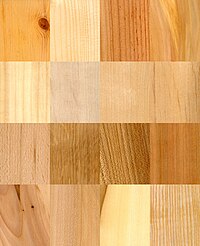
Photo from wikipedia
Bending of solid wood from European oak is one of the most demanding technological processes due to its specific structural and physical properties and variability. We investigated the influence of… Click to show full abstract
Bending of solid wood from European oak is one of the most demanding technological processes due to its specific structural and physical properties and variability. We investigated the influence of wood moisture content (MC) and stiffness, determined by NDT, as well as previous drying methods on the bending ability of the wood. The best quality was obtained with bending specimens bent at a moisture content of at least 16% and quarter- or semi-quartersawn. The number of rejected specimens increased slightly when HF bending was used. Single-stage predrying of oak to a final MC of 8% resulted in a high rejection rate (>70%) regardless of drying technique. The acceptance rate was higher for less stiff specimens where the ratio of ultrasonic velocity in the straight (vS) and bent region (vB) was less than 0.5 (vB/vS).
Journal Title: Forests
Year Published: 2023
Link to full text (if available)
Share on Social Media: Sign Up to like & get
recommendations!